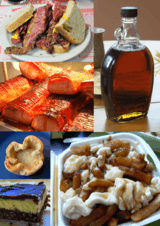Rubaboo
Rubaboo is a common stew or porridge consumed by coureurs des bois and voyageurs (French fur traders) and Métis people[1] of North America. This dish is traditionally made of peas and/ or corn, with grease (bear or pork) and a thickening agent (bread or flour) that makes up the base of the stew.[2] Pemmican[3] and maple sugar were also commonly added to the mixture. Rubaboo that is made by the Plains Metis is often made with pemmican, rabbit, prairie chicken or sage hen and a wide variety of wild vegetables such as wild parsnip (lii naavoo) onion, turnip, and asparagus that can all be added to the food with preference.[4] The thickened mixture was later re-served as “rowschow” (re-chaud).[5] Sometimes, It is occasionally spelled Rubbaboo. Other sources describe it as consisting primarily of boiled pemmican, with thickening agents added when available.[3][6]
| Alternative names | Rubbaboo |
|---|---|
| Type | /Porridge/Stew |
| Place of origin | Canada |
| Region or state | Rupert's Land |
| Serving temperature | Hot |
| Main ingredients | Peas or corn, fat (bear or pork), bread or flour, pemmican |
| Variations | Rubaboo |
 |
| Part of a series on |
| Canadian cuisine |
|---|
|
Regional cuisines |
|
Ingredients |
|
Styles and dishes
|
|
Religious and ethnic
|
|
Rituals and festivals
|
|
Origins
The etymology of the word is a blend of the French word roux (a thickener used in gravies and sauces) with the word for soup ("aboo") from an Algonquian language,[7] such as Anishnaabe naboo.[8] Although pemmican can be added to the stew, Rubaboo and pemmican remain separate dishes, but are culturally linked closely to each other in Metis history.[9]
Rubaboo Aboriginal Arts Festival
Apart from its first definition, Rubaboo has also gained a newer meaning, when an Indigenous cultural festival under the same name, that was founded in the year 2009.[10] Rubaboo Aboriginal arts festival has been in operation for ten years, and the festival focuses on Indigenous and Metis celebrations of culture, with live performances and vendors in attendance.[11] The Rubaboo cultural arts festival takes place in Alberta annually, and is a different meaning to the cultural dish meaning of the word Rubaboo.[12][13]
http://albertaaboriginalarts.ca
See also
- Métis
- Métis in Canada
- Kama (food)
- List of porridges
- List of stews
- Roux
- Coureur des bois
Sources
- Arts, A. A. (2009, January 1). About Us. Retrieved 22 November 2019 from http://albertaaboriginalarts.ca/
- Barkwell, Lawrence J.; Dorion, Leah; Hourie, Audreen (2006). Métis Legacy (Volume II) Michif Culture, Heritage, and Folkways. Winnipeg: Pemmican Publications Inc. and Saskatoon: Gabriel Dumont Institute. ISBN 0-920915-80-9.
- Gordon, Irene Ternier (1 February 2011). A People on the Move: The Métis of the Western Plains. Heritage House Publishing Co. p. 20 ISBN 9781926936123 Retrieved 21 November 2019.
- Weaver, S. M., Brockway, R. W., & Blue, A. W. (1982). Book Reviews. Canadian Journal of Native Studies, Vol. 2, Pp. 395–414., Vol. 2, 395–414.Retrieved 22 November 2019 from https://iportal.usask.ca/index.php?t=display_solr_search&having=4303766&sid=168308311
- PEMMICAN.(1961). Nutrition Reviews, 19(3), 73–75. Retrieved 23 November 2019 from https://academic.oup.com/nutritionreviews/article-abstract/19/3/73/2672002?redirectedFrom=fulltext
References
- Lawson, Jennifer; McDowell, Linda; Thomson, Barbara (9 June 2019). Manitoba: Past and Present : Hands-on Social Studies, Grade 4. Portage & Main Press. p. 186. ISBN 9781553790341. Retrieved 9 June 2019 – via Google Books.
- Weaver, S. M., Brockway, R. W., & Blue, A. W (1982). "Book Reviews". Canadian Journal of Native Studies. 2 (2): 395–414. Retrieved 22 November 2019.CS1 maint: multiple names: authors list (link)
- Gordon, Irene Ternier (1 February 2011). A People on the Move: The Métis of the Western Plains. Heritage House Publishing Co. p. 20. ISBN 9781926936123. Retrieved 10 November 2019 – via Google Books.
- Weaver, S. M., Brockway, R. W., & Blue, A. W (1982). "Book Reviews". Canadian Journal of Native Studies. 2 (2): 395–414. Retrieved 22 November 2019.CS1 maint: multiple names: authors list (link)
- Bryce, George (2005-12-19). The Romantic Settlement of Lord Selkirk's Colonists The Pioneers of Manitoba (1 ed.). Retrieved 20 November 2019.
- Nute, Grace Lee.The Voyageur. Minnesota Historical Society, ISBN 978-0-87351-213-8, p. 55
- "Cree, Assiniboine, Ojibwa and Michif: The Nehiyaw Pwat Confederacy/Iron Alliance in Montana - Blackfoot Confederacy (165 views)". Scribd.com. p. 13. Retrieved 9 June 2019.
- "Pemmican". Nutrition News Journal. 19 (3): 73–75. 1961. doi:10.1111/j.1753-4887.1961.tb01895.x. Retrieved 22 November 2019.
- "About Us". Alberta AboriginalArts. Alberta AboriginalArts. Retrieved 22 November 2019.
- "Home". Alberta Aboriginal Arts. Retrieved 23 November 2019.
- Gordon, Irene Ternier (2009). A People on the Move : The Métis of the Western Plains. Victoria, B.C: Herritage House. Retrieved 24 November 2019.
- "Home". Alberta Aboriginal Arts. Alberta Aboriginal Arts. Retrieved 24 November 2019.